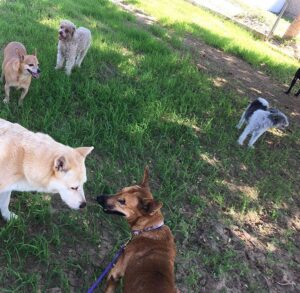¿Es tu perro sociable??
"Socialización", ¿Qué significa cuando se trata de perros?. La mayoría de nosotros sabemos cómo socializar con los humanos., pero es posible que hayamos visto personas socialmente incómodas en determinadas situaciones..
con caninos, es similar, Los perros serán socialmente incómodos en situaciones a las que no están acostumbrados.. Sus reacciones podrían incluso ser como las de las personas., Las personas tímidas se quedarán atrás y no se relacionarán con los demás., Algunas personas ocupan el espacio de los demás o hablan demasiado alto para superar su timidez..
El momento ideal para socializar a los cachorros es cuando están 4 semanas para 4 meses de edad. Aquí es cuando quieres exponerlos a todo tipo de estímulos.. ruidos fuertes, tráfico, lagos o playas, muchas personas y animales diferentes deberían estar en tu lista de entornos para exponer a tus pequeños.

Los perros son rescatados de muchas circunstancias diferentes. A menudo, cuando adoptas un rescate, no conoces sus antecedentes y a qué tienen o no han sido expuestos. Los perros que viven en áreas rurales que de repente se encuentran en un entorno de la ciudad urbana reaccionarán a los nuevos olores, ruidos, e incluso cambios climáticos que no son familiares.
La socialización no significa solo presentar a su perro a otros perros y personas. Se está introduciendo y que su perro se sienta cómodo en nuevos entornos y circunstancias..
Hacer eso, Debe exponerlos a todo tipo de cosas que quizás no hayan experimentado antes. Dependiendo del perro, Querrá tomar esto lentamente y ver su lenguaje corporal para decirle lo que tiene miedo y a qué están acostumbrados.
 Perros que nacen y crecen en un ambiente desértico como los aquí en México, tener un mundo completamente nuevo para acostumbrarse cuando sean adoptados y enviados al noroeste del Pacífico o Canadá. Las cosas que damos por sentado como el césped o la lluvia fría y la nieve son algo que nunca antes habían experimentado. Los olores son diferentes, Es posible que no estén acostumbrados a los ruidos de tráfico de grandes camiones o autobuses.. Una introducción lenta a estos estímulos permitirá que el perro se ajuste a su propio ritmo. No lo apresure, Porque si la experiencia es demasiado estresante, entonces es probable que esté creando una experiencia negativa en lugar de la positiva que estaba buscando.
Perros que nacen y crecen en un ambiente desértico como los aquí en México, tener un mundo completamente nuevo para acostumbrarse cuando sean adoptados y enviados al noroeste del Pacífico o Canadá. Las cosas que damos por sentado como el césped o la lluvia fría y la nieve son algo que nunca antes habían experimentado. Los olores son diferentes, Es posible que no estén acostumbrados a los ruidos de tráfico de grandes camiones o autobuses.. Una introducción lenta a estos estímulos permitirá que el perro se ajuste a su propio ritmo. No lo apresure, Porque si la experiencia es demasiado estresante, entonces es probable que esté creando una experiencia negativa en lugar de la positiva que estaba buscando.
Los perros tímidos o temerosos pueden aprender a confiar y superar su miedo.
Sin embargo, Debes ir a su ritmo. Demasiado demasiado pronto puede empeorar su reacción. El objetivo es crear una experiencia positiva divertida para el perro.. Muchos elogios cuando dan ese primer paso hacia el comportamiento que deseas. Trata cuando hacen lo que se espera de ellos.
Es probable que los perros que dudan o temeran son aquellos que nunca han experimentado esta situación en el pasado y no están familiarizados con el nuevo entorno. Algunos ejemplos de lenguaje corporal serían una cola escondida, orejas planas, Lamiendo sus labios, bostezo, sacudida, gimoteo, o cuerpo agachado. @Photo cortesía de ASPCA

Lo que hay que recordar es que no todos los perros serán sociales todo el tiempo.
Este gráfico es un ejemplo perfecto que en el mundo de los perros, Al igual que la gente, Algunos son muy sociales, la mayoría son tolerantes, y muchos son agresivos o no muy agradables. También hay una escala deslizante en la que los perros cambiarán su sociabilidad a medida que maduren y la edad..

Consejos sobre cómo socializar a su perro
- Crear experiencias positivas - Recompensa al perro con elogios o tratados cuando se mueven hacia esa cosa aterradora
- Los encuentros breves son los mejores - Las presentaciones en la correa a otros perros son mejor mantenidos breves y recompensan el buen comportamiento después de que los otros perros sigan adelante.
- Comience con un entorno fácil primero - No intentes exceder el umbral de estrés de tu perro demasiado pronto, pasos, y ver crecer su confianza
- Retire a su perro de una situación de alto estrés rápidamente - Espere lo inesperado. Si surge algo estresante, Saca a tu perro y relájalos con afecto físico o recompensas de juego/comida.
